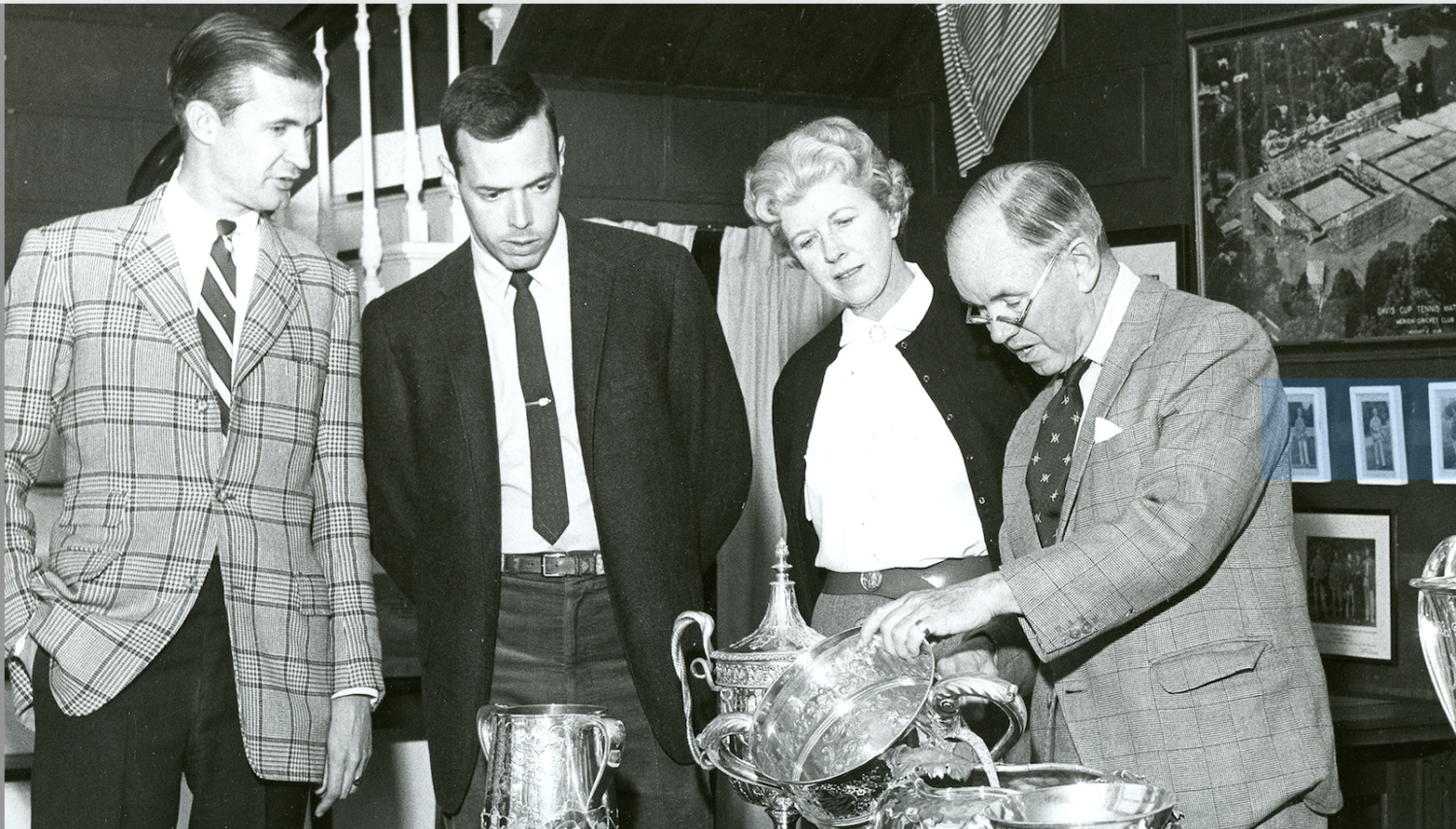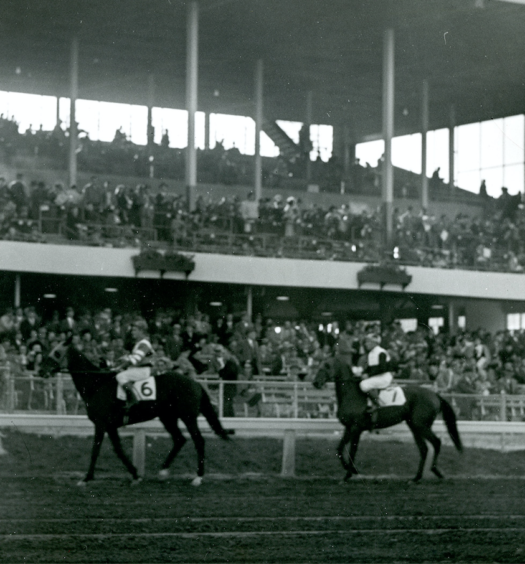[Editor’s Note: I first attended a tennis match at the Casino at Newport in 1969, when I was eleven years old. I had the pleasure of seeing stars such as Australians Rod Laver and John Newcombe. In 1972 I saw the great Margaret Court defeat Billie Jean King in the finals of the Virginia Slims of Newport. I returned to the Casino grounds to watch tennis only in the last two weeks, attending two days of matches at the Infosys Hall of Fame Open. It was great fun. On the second day, I saw several matches. My favorite was standing behind fences on Court 1 or Court 2 watching great professional tennis players from only a few feet away. The main Stadium Court does not have a bad seat. I decided at the last minute to attend the finals, arriving late. Alexander Bublik, who had earlier beat legend Andy Murray, had won the first set and was up 3-0 in the second set. It appeared to be a bad investment for me. But American Maxime Cressy, with his serve and volley game, stormed back to the take the second set, and won the final set 7-6 (7-3 in the tiebreaker) and the championship. As I was about the enter the wonderful and historic grassy grounds of the Casino, I heard a young man ahead of me saying out loud to his friends, “Hah, it says here its the Tennis Hall of Fame. That can’t be true.” Yes, it is true. The grounds of the Casino also host the International Tennis Hall of Fame and it is worth visiting. This is Helen Farrell’s second article on the history of Newport tennis. This one was written in 1969 and appeared in the Rhode Island Yearbook for 1972.]
In my last article on the history of Newport and tennis at the Casino, I described the first United States Lawn Tennis Association Singles Championship held at the Casino in 1881 and for the next thirty-one years. My article ended with the sad news (for Newport but not for the growth of Tennis) that the United States Lawn Tennis Association changed the location of its National Men’s Championship in 1915 to Forest Hills in the borough of Queens in New York City, where it remains to this day.
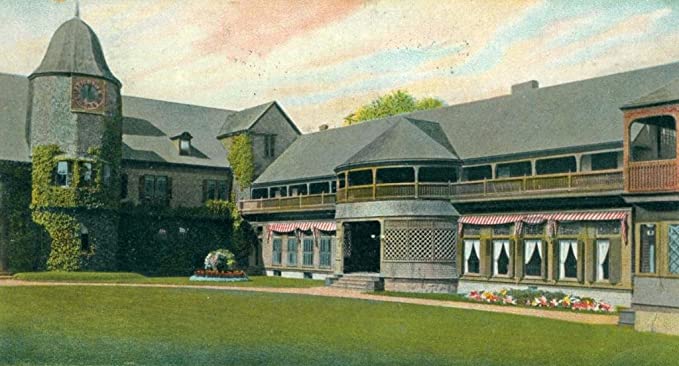
“Newport Casino” Postcard, circa 1900. The Newport Casino is a grass-court tennis complex and recreation center located at 186-202 Bellevue Avenue, Newport, Rhode Island. Built in 1880, it was designated a National Historic Landmark on February 27, 1987, in recognition for its architectural significance as one of the nation’s finest Shingle style buildings, and for its importance in the history of tennis in the United States. The complex now houses the International Tennis Hall of Fame, and was the site of the earliest US Opens, starting in 1881.
Professional tennis did not end in Newport after 1915. To the contrary, another great annual tennis event was held each year from 1915 to 1967, the Newport Casino Invitational. Many of the greats played here, including Bill Tilden, Don Budge, and Rod Laver. Them, thanks to the influence and hard work of Newport’s James Van Alen, Newport was selected to host and house the International Tennis Hall of Fame.
“Democracy may demand that championship crowds should be nearer a city’s heart, but the heart of the old lawn tennis lover will always beat fastest on the Casino courts.” So declared A. Wallis Myers, a British tennis writer in 1923.
Nostalgia and sport blend today at the Casino in Newport, almost ninety years after the first National Lawn Tennis Champion, Richard Sears of Boston, won his title. At Newport, the tennis lover can see the place where the 1881 title was won, the bowl Sears claimed, and the game in which he excelled played by Casino members and world-renowned professionals.. For the National Lawn Tennis Hall of Fame is housed in the graceful building on Bellevue Avenue, the only “working” sports shrine in the country. Mrs. Robert H. Haire, the Executive Secretary, and the Hall of Fame staff are there to greet you. If you are very lucky, she or Joe Leandra, the pro since some dim day in the Forties, may be waylaid for a yarn about the day, not too long ago, when “everyone was here but the Pope.” For Newport tennis, that rare blend of sport and society, goes on.
Tennis at the Casino has drawn many famous guests to Newport. General John Pershing, the Duke of Windsor, Presidents Eisenhower and Kennedy are only a few. The excellence of the sport, played at its American birthplace, continues to lure visitors from every tennis-playing nation. The weathered shingles of Stanford White’s pavilion, the brilliant blue of the Casino’s hydrangeas, and the lush green courts make the Casino scene as beautiful as it is sportive.
The United States Lawn Tennis Association changed the locale, of its National Men’s Championship in 1915. Tennis had attracted national, attention and drew galleries that engulfed the graceful arc of Stanford White’s shingled sports rendezvous. Forest Hills was a subway ride from New York, and plans were already laid for the eagle-emblazoned stadium that opened there in 1925.
Undaunted, the Casino’s governors announced a new tournament to precede Southampton, Longwood, and Forest Hills on the grass court circuit. It was the Annual Invitation Tournament of the Newport Casino. Until 1968, the year that Wimbledon was declared “open” to professional players, this amateur tournament consistently drew the top players of the world to Newport. The professional tournament that has now taken its place attracts equally impressive draws.
Craig Biddle headed the 1915 tournament committee. Fifty-five entrants were invited, according to American Lawn Tennis, a “classy entrance list”. Eleanor Elkins Widener inaugurated her famous Tennis Week balls at Miramar, a series that lasted through 1937. Former Rhode Island Governor R. L. Beeckman, the 1886 runner-up, entertained, and the Clambake Club was the scene of a tennis celebration. The Invitation Tournaments were off to a glorious start.
- Norris Williams, 2nd defeated the “California Comet,” Maurice E. McLoughlin, for the title, 5-7, 6-4, 6-3, and 6-3. McLoughlin had carried away the 1912 and 1913 National Championships at Newport. The doubles trophy went to Clarence J. Griffin and William M. Johnston.
Ichiya Kumagae, the Japanese player still so respected by the tennis world, was the surprise of the 1916 Invitational. He defeated Johnston, 6-1, 9-7, 5-7, 2-6, 9-7 in a match of suspense and sportsmanship long remembered. Mr. Kumagae’s daughter kindly and proudly translated her father’s dispatch to the Japanese papers for this article. Mr. Kumagae gracefully remarks on the hospitable Newporters who “invite tennis players as honorable guests”. He describes the quavering heat waves of the August day, and makes light of his uncertainties on the grass surface. Against Johnston’s “beautiful refined technique” Kumagae’s “awkward country style” held. After a victor’s jazz-band party at Bailey’s Beach, Kumagae and two dozen other players boarded Whileaway, Harry Payne Whitney’s yacht, to “sail away from Newport to the next battlefield, Southampton.”
The years 1917 and 1918 were war years; play resumed in 1919. William T. Tilden took his first Newport title then, against “Little Bill” Johnston, and the great tennis duels of the Twenties were on. In 1925- Johnston got his third leg on the Casino trophy, and became its owner. James Stewart Cushman contributed a new prize, only to see it go to Tilden four years later. George Lott’s is the only other name on the Cushman cup.
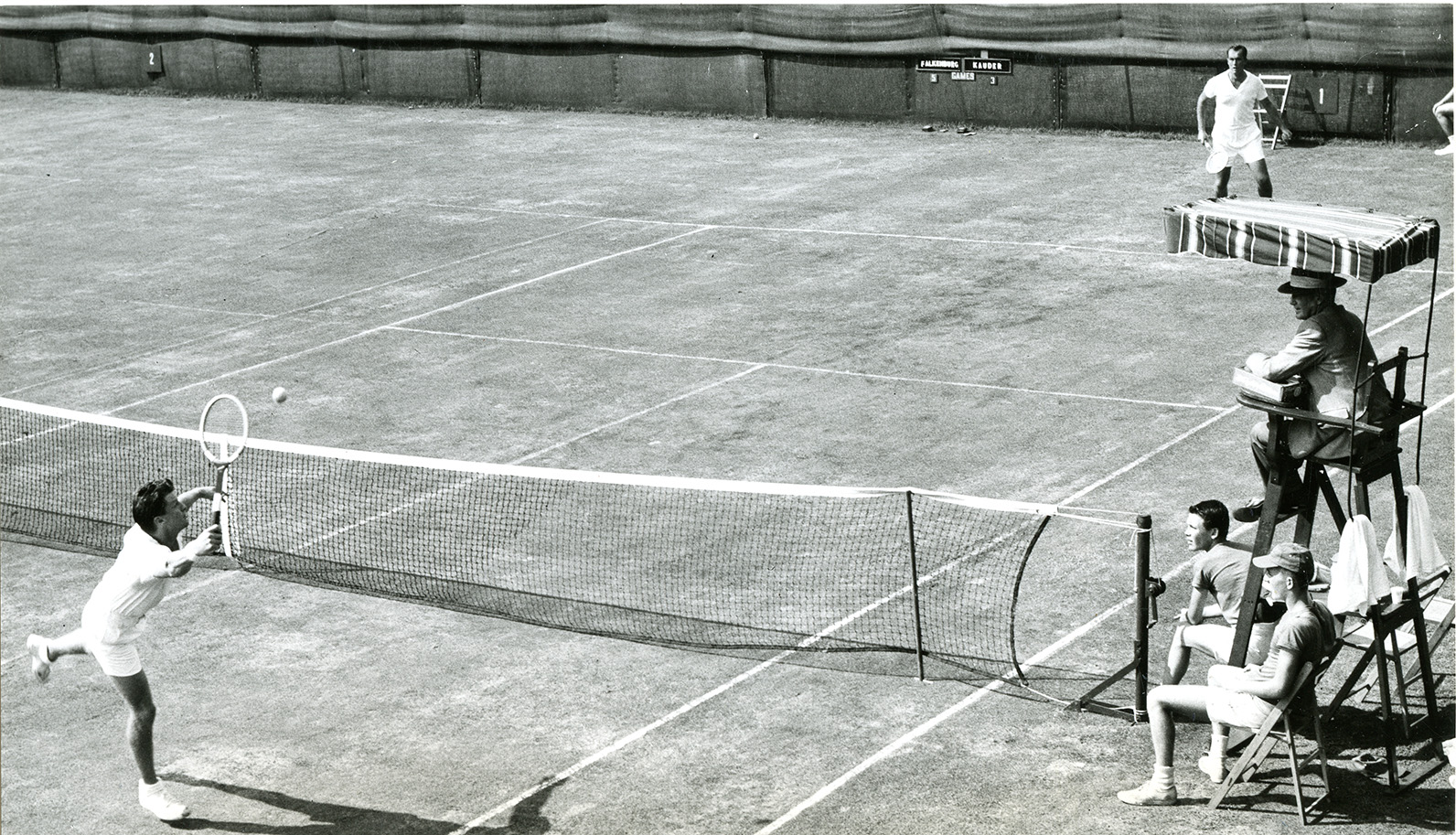
Action at the Newport Casino Invitational, circa 1965. The score is Falkenberg 5 games to Kauder 3 games (Providence Public Library Digital Collections)
International play sparked Newport seasons through the Twenties. Kumagae was joined by his countryman, Zenzo Shimidzu. Manuel and Jose Alonso, Spanish Davis. Cuppers, John Bromwich from Australia, and Fred Perry from England added to the international flavor. France’s “Four Horsemen”, Borotra, Cochet, Brugnon, and Lacoste who held the Davis Cup in their country from 1927 to 1933, were also on Newport courts.
Rene Lacoste has kindly recalled Newport of 1927, just before the. Davis Cup finals at Forest Hills. The French captain had recommended Newport practice, and so the quartet arrived, only to face four days of Brenton’s Reef fog. “My memories of Newport thus cover only a few glimpses of rain-soaked grass courts and, more fortunately, of a magnificent ballroom. I remember some marble staircases quite worthy of Versailles!” They played not at all, it seems, but the aura of Newport was just the cure the team needed, for they took the Cup at Forest Hills. Lacoste gratefully recalls that “some Newport Charleston did a lot of good for my tennis some forty years ago.”
Jose Alonso, whose brother, Manuel, was runner-up to Tilden at Newport in 1927, found Newport memories “very marked, because they were so pleasant. . . . The doors were open for us in all the clubs, and Bailey’s Beach was a meeting place.” He recalls the “delight of playing on some of the very best grass courts in the world, amongst the beautiful setting of the Casino . . . although it was hard to get used to playing while the string orchestra was performing.”
Francis. T. Hunter, a four-time winner at Wimbledon, maintains that playing at Newport surpassed the thrill of performing before the crowned heads of Europe. Perhaps, he writes, “the inspiration was because one was competing before a knowledgeable gallery . . . or perhaps it was the perfection of the courts, the courtesies and niceties that always existed there.”
Behind these courtesies lay months of planning by the Casino governors. Following Craig Biddle’s effective managership, James Stewart Cushman took over the Tennis Committee. He was always on hand in June at Wimbledon, signing up, players for the Casino. He took keen interest in the happiness of the players, and in their careers, although Wilmer Allison, the 1934 Newport winner, writes of a “good, kind Mr. Cushman who could never understand why we did not want to go to some socialite luncheon after playing five hard sets in the morning with five more facing us in the afternoon.” A steadfast churchman, it was hard going: to convince Mr. Cushman to schedule finals play on Sundays in the Fifties.
Another Newporter devoted to the game was Mrs. Maude Barger-Wallach, the 1908 National Champion. She is on hand in many old presentation pictures in the Hall of Fame. Her rivalry with Eleonora Sears for the best mixed-doubles partners was always watched with zest. Mrs. Barger-Wallach donated the Singles Cup in 1939 after Donald Budge retired its predecessor. Budge had achieved his “Grand Slam” in 1938: the American, Australian, British, and French titles.
Maude and Edith Wetmore, the owners of the Chateau-sur-Mer mansion, were also devoted to “the Tennis,” and to the Casino. The closeness of the Newport people to the event is best illustrated by the value laid on subscriptions to boxes for Tennis Week. Like seats for symphony orchestras, they often appeared in wills.
The current Newport Invitation Doubles trophy, established in 1950, is named for Thomas Pettitt. Mr. Pettitt came to Newport as the Casino’s first court tennis professional, in 1881. Four years later he became World Champion of the esoteric sport, at Hampton Court, England. He held the title to 1898, and the title of Casino tennis professional until his death in 1946.
During World War II the Casino club rooms above Bellevue Avenue were turned into an Officers’ Club. Despite a devastating locker room fire and a desolate financial picture, Henry D. Phelps took on the Casino presidency in 1945. Under his leadership, the Invitation Tournament was reconvened in 1946. Gardner Mulloy defeated Ted Schroeder, 6-1, 2-6, 14-12, 6-3. Jack Kramer and Schroeder defeated William Talbert and Robert Falkenberg 4-6, 6-3, 7-5, 6-3.
James Van Alen was elected president of the Casino in 1951. Mr. Van Alen’s family was a part of the Casino at its founding. His mother was Margaret Louise Post, and his paternal grandparents included Emily Astor of the wealthy and socially prominent Astor family. Mrs. Louis Bruguiere was a particular admirer of the lovely theater building Stanford White designed for the complex, and always supported the various activities there. Tennis was Mr. Van Alen’s forte; he captained the team while at Christ’s College in Cambridge (Great Britain) in 1924 and later became a court tennis champion.
As president, Mr. Van Alen determined to continue the famous Invitation Tournament, but he also wanted to create a tennis center on the site of its American establishment. In 1954, therefore, the Casino governors petitioned the USLTA, for official recognition of their club as the true cradle of tennis in the United States. The honor was granted. William J. Clothier, the-1906 Champion, was named President of the National Lawn Tennis Hall of Fame and Tennis Museum. Players, sponsors, and sports writers immediately began to contribute to the museum. “Enshrinement,” the annual honoring of tennis figures, was inaugurated. Allison Danzig of The New York Times (enshrined in 1968), dedicated the Hall of Fame to illuminating the past glories of tennis, honoring those distinguished in tennis history, and promoting the sport’s welfare.
”Now,” says Mr. Van Alen, “a lover of tennis can come to Newport and see the finest of the past and present in tennis — major competition on the actual grass courts used by our first champion, and a museum commemorating the greats from. Sears himself to the present. There’s no Hall of Fame like it.” Silver trophies gleam in the gallery windows of the graceful shingled building, within yards of the lush green turf and the sounds of the honored game. Tributes, photos, letters and news clippings from the days of Henry W. Slocum and Dr. James Dwight, the “Father of American Tennis,” down to the stars of today fill the rooms. The Sears Bowl, a grape-embellished Gorham silver punch bowl, reflects the sheen of other prizes. A neighboring window frames the cup that Maurice McLoughlin took off to California in 1913. Although Tilden was notorious for handing out his silverware, the Museum has a pair of pewter doubles cups from an early match and, thanks to a partner, Alexander Weiner, the gold medal the USLTA struck for him when he held its three titles, with Vincent Richards and Molla Bjurstedt Mallory. A bronze of this Nordic star dominates a collection of her trophies and photos.
Memorabilia includes Beals Wright’s blazer patch as Davis Cup Captain in 1906, 1908 and 1911. An autographed menu of a Delmonico dinner honoring the 1913 Cup team is there, and so is a framed sheet of R. M. S. Niagara note paper, signed by those knights-errant, Tilden, Johnston, Hardy, and Washburn, “in quest of the Davis Cup, November, 1920.”
Upstairs, a paneled room is devoted to court tennis, the predecessor of our lawn tennis. Tom Pettitt’s prize pupil, Jay Gould, (World Champion, 1906-26) is hailed here, and so is Mr. Van Alen. A bronze statue of Pierre Etchebaster, World Champion from 1928 to 1954 is exhibited, as well as a table model of the intricate court The Casino’s own court has been out of use for years Here, too, are ranked the varied sporting trophies o Theodore Roosevelt Pell (Rhode Island Senator Claiborne Pell’s cousin), a frequent Newport contender and a National Indoor Champion.
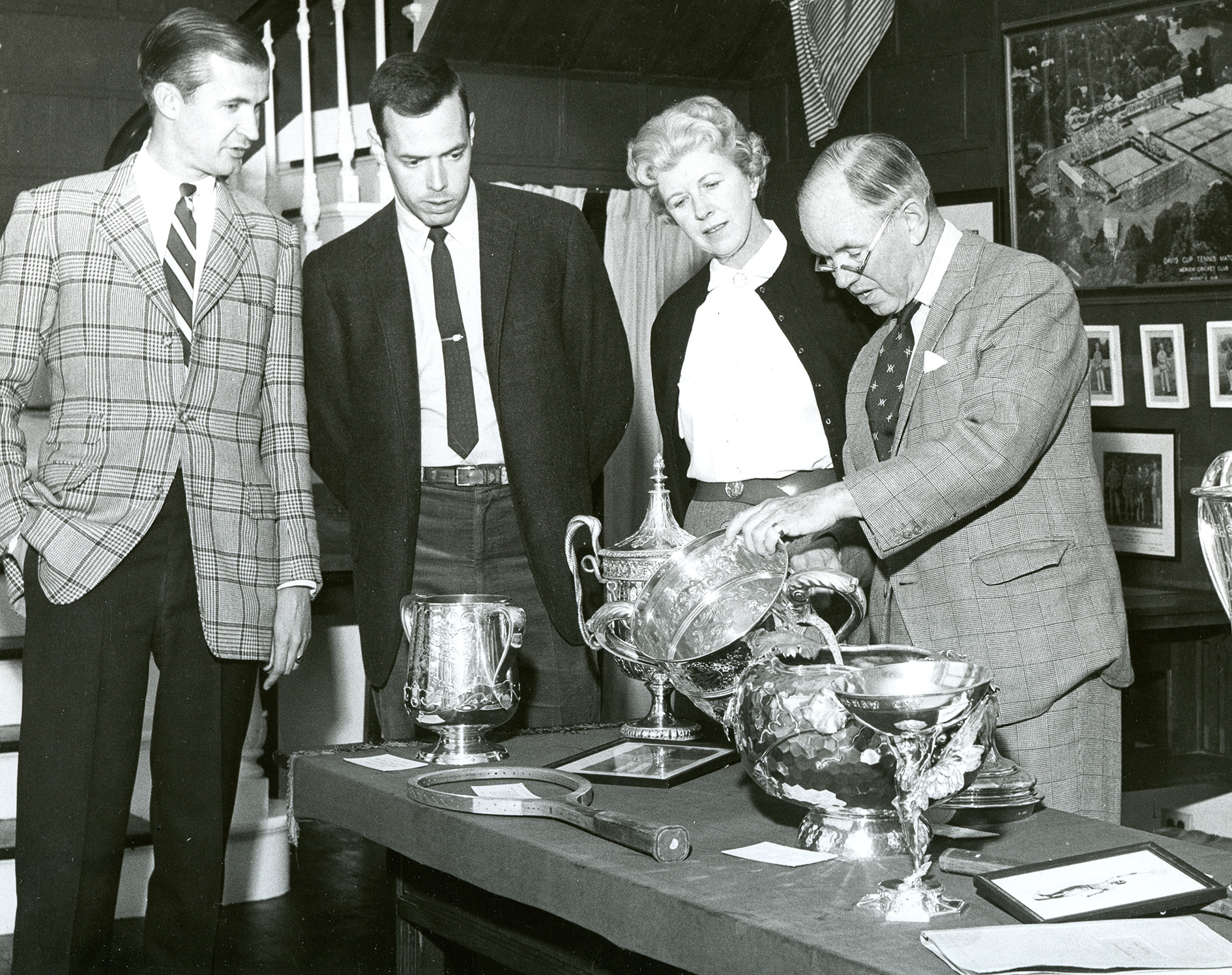
Newport’s great promoter and innovator of tennis, James Van Alen, shows championship trophies to bystanders at the Tennis Hall of Fame (Providence Public Library Digital Collections)
The Doubles Room completes the show. Photos of al the National Champions and the Father-and-Son winners are ranged here. J. D. E. Jones and his son Arnold of Providence, Champions in 1922, 1925 and from 1928 to 1932 are pictured. The Joneses, with Malcolm Chace, brought Tilden himself to Providence in the Twenties, and made the East Side Tennis Club and the Agawam Hunt tournaments great affairs.
Like any museum, the Hall of Fame is not complete. Memorabilia from players and their families is constantly arriving. Mr. Van Alen hopes to add many exhibits, including a suite of tennis dresses by Teddy Tingling, the London designer. It will include the outfit of Mary K. Brown; Champion 1912-14, who admits, “we all dressed abominably in those days for the game.”
Mr. Van Alen has included the famous Casino Theater in his plans. This lovely gold-and-white hall has had brilliant summer seasons. In 1963 a series of weekend concerts was presented under the direction of “Newport Weekends.” Another series followed and, in 1968, the Newport Players Guild launched an ambitious year-round program, transforming the theater into a community center for the performing arts.
[Editor’s note: While I have not been able to determine when the first African-American played in a major tennis tournament in Newport, I do know that Arthur Ashe first played in the Newport Casino Invitational in 1964, as an amateur. Henry Heffernan wrote in the Newport Daily News’s August 6, 1964 edition, that Ashe was “the first Negro play of caliber since Althea Gibson. Young and wiry, Ashe has every shot and hits with power and authority. An added asset is his well-controlled emotions. Many points (and matches) are lost on the temper produced by a ‘bad call’ or an opponent’s ‘gamesmanship.’” It appears that the first African-American to win a major tournament in Newport was Zina Garrison, who won the Virginia Slims of Newport tournament in 1989.]Tennis goes on at the Casino from June 1 to October 31. Junior Davis Cup, Rhode Island Junior Championships, and occasional USLTA tournaments are held. But the most exciting time to be there is still Tennis Week, the middle of August. The professionals play under the Van Alen Streamlined Scoring System, known to all as VASSS. Similar to table-tennis scoring with a 31-point game, VASSS assures the fan evenly timed matches averaging half an hour. The imbalance of deuce sets is replaced with a view of more stars. As if arranged to prove Mr. Van Alen’s long-battled point, in 1967 a game record was set at Newport: 147, with the score 3-6, 49-47, and 22-20. VASSS is also calculated to reduce the advantage of a powerful serve: the server may be required to stand three feet behind the service line. [Editor’s note: The VASS system of scoring never caught on and is no longer used in tennis. But he did introduce a revolutionary tie-breaker of best of nine points; today the tie-breaker is the first player to reach seven points. The VASS Pro Tennis Championships was held in Newport from 1965 to 1970.]
On Saturday of the tournament, enshrinement takes place. Sportsmanship and contribution to the sport are equal to titles in qualifying for the honor. Sears and six contemporaries were first, in 1955. In 1957, all four early luminaries were in Newport, on the center court: Mary K. Browne, 1912-14, Hazel Hotchkiss Wightman, 1909-11 and 1919, Maurice McLoughlin, 1912-13, and R. Norris Williams, 2nd, 1914 and 1916. Henry Heffernan, treasurer of the Hall of Fame, was with Mr. McLoughlin when the tall, white-haired athlete caught his first sight of the courts through Stanford White’s shadowy archway. “That moment alone,” said Mr. Heffernan, “justifies the entire Hall of Fame.”
William F. Talbert won the Newport title in 1942, and was enshrined in 1967. “It always seemed that I played my very best at the Casino,” he recalls, and he played in Newport from 1936 to 1954. 1968 meant enshrinement for Maureen Connolly Brinker, Jack Kramer, Pancho Gonzales, Eleonora Sears and Allison Danzig.
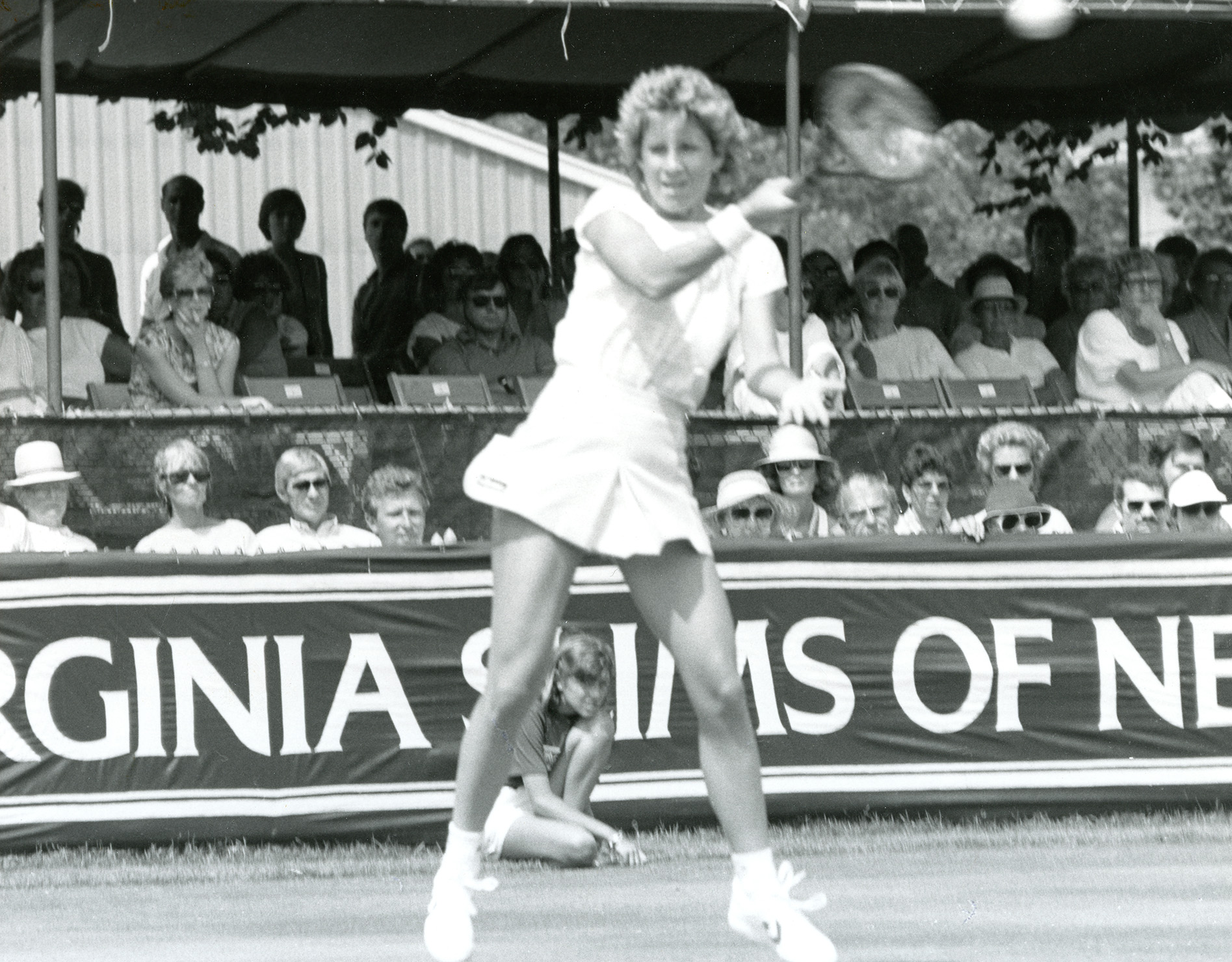
Chris Evert striking a tennis ball at the Virginia Slims Tournament held at the Newport Casino. The tennis great won the championship in 1974. She would return and win the singles title at Newport in 1985. (Providence Public Library Digital Collections)
The honor was accorded champion players Karl Behr, Doris Hart, Arthur Larson and Marie Wagner in 1969. Charles Garland of Baltimore, a tennis patron, was also enshrined.
Frank Sedgman, who won the Newport title in 1951 and 1952, looks back on the Casino, recalling its resemblance to his own club in Melbourne at the Albert Ground, where the Davis Cup matches were first played. “Year after year I look forward to the Newport tournament, for it was there that you could relax by swimming and social life, and take your mind off the arduous task of playing tennis day after day and forget to some extent the grasping and fighting for higher rankings.” Perhaps Sedgman has it here, the Newport spirit of sportsmanship.
Annual Invitation Tournament
The Casino, Newport, Rhode Island
Champions, 1915-1967
1915 R. Norris Williams, 2nd
1916 Ichiya Kumagae
1919 William T. Tilden
1920 Clarence J. Griffin
1921 Watson Washburn
1922 William M. Johnston
1923 Howard O. Kinsey
1924 William M. Johnston
1925 William M. Johnston
1926 William T. Tilden
1927 William T. Tilden
1928 George M. Lott
1929 William T. Tilden
1930 William T. Tilden
1931 Ellsworth Vines
1932 Ellsworth Vines
1933 Francis X. Shields
1934 Wilmer Allison
1935 J. Donald Budge
1936 Robert L. Riggs
1937 J. Donald Budge
1938 J. Donald Budge
1939 Elwood T. Cooke
1940 Don McNeill
1941 Don McNeill
1942 William Talbert
1946 Gardner Mulloy
1947 F. H. Schroeder, Jr.
1948 William Talbert
1949 Richard A. Gonzales
1950 F R. Schroeder, Jr.
1951 Frank Sedgman
1952 Frank Sedgman
1953 Tony Trabert
1954 Hamilton Richardson
1955 Hamilton Richardson
1956 Kenneth Rosewall
1957 Anderson Malcolm
1958 Anderson Malcolm
1959 Anthony Pikard
1960 Rodney Laver
1961 Robert Mark
1962 Charles McKinley
1963 Ian Crookenden
1964 Charles McKinley
1965 Roy Emerson
1966 Dennis Ralston
1967 William Bowrey

